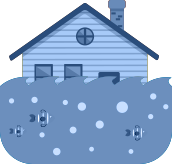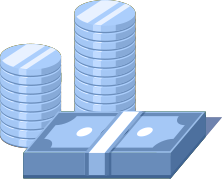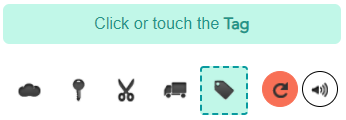Compare Homeowners Insurance Rates
Learn more about the factors that dictate your homeowners insurance rates, compare top insurers, and save.
 Your information is secure.
Your information is secure. HOMEOWNER (PROPERTY):

Homeowners Insurance Coverage
Home is where your heart is—along with a healthy chunk of your net worth. Few common items covered by homeowners insurance are:
Property Damage
Most policies provide coverage for damage to your house and any permanent structures on your property for:
- Fire
- Hail
- Wind
- Water damage (unless excluded by your policy)
Personal Property
Coverage for damage to or theft of your stuff, like:
- Furniture
- Appliances
- Clothing
- Even dishes (in some cases)


Jewelry
Limited coverage, (usually $500 - $2,000), for jewelry stolen from your home. If your collection is worth more, let us help you with a jewelry policy to cover your valuables.

Personal Liability
Could help cover medical expenses or property damage to others caused by you or members of your household, including pets. It could also help with legal expenses in the case of a law suit.

Medical Bills
Medical payments coverage for minor injuries to people who don't live with you but are injured on your property.

Additional Expenses
Coverage for extra costs you might have to pay when experiencing a covered loss.
What is home insurance?
If you're among the 65% of Americans who own a home, you understand the immense financial investment that is homeownership. You need to make sure your investment and your personal property are thoroughly protected. That's where homeowners insurance comes in.
Do I need homeowners insurance?
Homeowners insurance is not legally required. But, if you have (or are getting) a mortgage, your lender will likely require you to purchase insurance to protect their investment.

How homeowners insurance is priced
Insurers consider a variety of factors, but they're really trying to answer two key questions: How likely are you to have a claim and how much will it cost. Here are some specifics: Large, expensive homes: More expensive homes cost more to repair. Low-damage area: If hail, tornadoes, crime, etc. aren't common where you live, you're less likely to have a claim. Brick/stone homes: These are less combustible than siding and other materials. Smoke alarms and other safety features: These prevent fires and burglaries. No claims in the past: This shows that you're a responsible homeowner and lowers your price.
What does home insurance cover?
A homeowners insurance policy is typically broken down into six parts:
- Coverage A - Dwelling: A house and any attached structures, such as a garage.
- Coverage B - Other structures: Any stand-alone structures — like a carport or tool shed — not attached to the home.
- Coverage C - Personal property: This covers repair or replacement of belongings or property stolen or damaged in a covered loss anywhere in the world.
- Coverage D - Additional living expenses: Sometimes called a loss-of-use clause, this helps to cover the cost of temporary relocation in the event the home is unliveable due to repair work.
- Coverage E - Personal liability: This covers the costs of another party's injuries on the insured party's property (or offsite).
- Coverage F - Medical payments: Covers medical costs incurred on the property by those not listed as residents of the household, regardless of fault.





Understanding homeowners insurance policy types: HO-2, HO-3, HO-5
The kind of coverage you will have with a home insurance policy will depend on the type of policy. There are two main ways you can have coverage in your homeowner's insurance: open and named peril. A peril is an action that causes damage to you, your home, or your belongings. Below are the definitions for the two
- Named peril: all the hazards and threats to your property that will be covered will be explicitly listed on your policy.
- Open peril: all the hazards that are not covered will be listed. This is a much broader form of coverage.
An HO-2 policy is a very bare-bones form of homeowner's insurance. It only covers your personal property and your dwelling structures for named perils.


A named peril HO-2 policy will cover:
- Fire
- Lightning
- Theft
- Vandalism
- Windstorms and hail
- Damage caused by vehicles
- Damage from aircraft
- Weight of ice, snow, and sleet
- Freezing of household systems
- Riots
- Explosions
- Falling objects
- Volcanic eruptions
- Water damage: overflow or discharge
- Damage from artificially-generated electrical current
- Sudden tearing, cracking or bulging of home
The next policy is an HO-3 policy - this is the most common policy in the US. It covers dwelling and structures on an open-peril home insurance policy but your contents on a named peril coverage.
HO-5. This coverage level includes coverage of both dwellings and personal property on an open-peril basis. Most insurance companies won’t insure against flooding, earthquake, landslides, mold, infestations, wear and tear, nuclear hazards, or government actions, regardless of homeowners insurance policy type.

How does home insurance work?
Insurance customers pay premiums to a home insurance company in return for the assurance that the insurance company will provide compensation — up to coverage limits — in the event of a total loss. As long as the homeowner — or their escrow — continues to pay and the cause of loss is a covered peril, the insurance company will honor repayment for damages.
How much homeowners insurance do I need?
The amount you spend on home insurance coverage depends on the replacement cost of your home, which your insurance company will usually help you determine. Consider that replacement cost and market value are not synonymous. Replacement value is how much it would cost an insurance company to rebuild your home and replace your belongings, whereas market value depends on the real estate market and other variables. Because the purpose of insurance is to restore the insured asset — your home and property, in this case — to its original state, insurance companies use replacement cost rather than market value to determine the actual dollar value of coverage.

Deductibles and home insurance
There are some major differences between car insurance deductibles and home insurance deductibles. With home insurance, your deductible is deducted from your claim payout instead of car insurance which needs to be paid before coverage kicks in. Example stove catches fire and sustains $8,000 worth of property damages and your deductible is $1,000, you would receive $7,000 and be responsible for covering the remaining amount.
Percentage versus dollar-based home insurance deductibles
Homeowners insurance deductibles can be dollar- or percentage-based. The above example of a stove fire would be considered a dollar-based deductible. For a percentage-based deductible, however, the monetary value is derived from a percentage of your dwelling coverage. For example, if your dwelling is valued at $395,000 and your wind and hail deductible is 1%, your deductible would be $3,950.

Actual cash value vs. replacement cost value
Most insurance companies will reimburse you for personal property claims via the actual cash value (ACV). ACV is the amount of money it would cost to replace an item, accounting for depreciation.
Homeowners insurance vs. hazard insurance
Like mortgage insurance (also known as private mortgage insurance, or PMI), hazard insurance is usually required by your lender when you buy a home. But unlike PMI, hazard insurance is not a separate insurance policy — to put it simply, it refers to the part of your homeowners policy that protects the structure of your home from certain perils like fire, lightning, and wind. Because of the financial stake the financial lender has in your new home, it is in their interest to safeguard the property against potential damage or destruction.

Average cost of ASI homeowners insurance by state
Low-cost states
Average monthly price: $50-70
Twelve-month average: $600-850 States included: Arizona, Delaware, District of Columbia, Indiana, Iowa, Maine, Maryland, Michigan, Nevada, New Mexico, North Carolina, Ohio, Oregon, Pennsylvania, Utah, Washington, West Virginia, and Wisconsin.
Why these are the most affordable states Favorable weather: Most of these states aren't coastal, meaning less extreme weather conditions. Lower home values: The median home values in these states will be less than other states, which means lower dwelling coverage amounts and meaning lower home insurance rates. Cheaper construction costs: Building materials are generally more affordable in these states.

Medium-cost states
Average monthly price: $75-100
Twelve-month average: 900-$1,200 States included: California, Georgia, Kentucky, Illinois, Mississippi, Missouri, Nebraska, New Jersey, New York, North Dakota, South Carolina, Tennessee, and Virginia.
Why these states rank in the middle per cost Fairly favorable weather: This group of states usually won't be affected by catastrophic weather as often as high-cost states. Higher home values: The median home values in these states are generally greater than those in low-priced states, which means more dwelling coverage is needed.

High-cost states
Average monthly price: 100-$150
Twelve-month average: $1200-$1,800 States included: Alabama, Colorado, Connecticut, Florida, Massachusetts, Kansas, Louisiana, Minnesota, Oklahoma, and Texas.
Why these are the most expensive states Severe weather issues: Tornadoes, hurricanes, and hail are usually more common in these 10 states, making them the biggest risks from a home insurance perspective.
Who does homeowners insurance cover?
Home insurance covers your family members who live in your household. Depending on your insurer, they may prefer that you explicitly name every household member on the policy. So if your spouse, children, relatives, or even the family pet causes damage to someone else's property, the liability portion of your homeowners insurance would extend to the liable family member. Typically, it also extends to cover family members who may be away from home — like your child who's heading off to college.
Does homeowners insurance cover mold?
Most homeowners policies will not cover mold unless it can be proved it was caused by a covered loss. If your policy provides no mold protection, you can add it back with a mold/fungi endorsement. This coverage is relatively limited.
Is homeowners insurance tax-deductible?
You can only deduct your homeowner’s insurance paid on a rental property, i.e., a home you own and rent out to a tenant. Aside from this circumstance, you may deduct premium payments to your private mortgage insurance (PMI).
It’s important to note that PMI isn’t your actual homeowner’s insurance but your mortgage insurance. If you’re unable to make the 20% required down payment on your mortgage and thus have private mortgage insurance, you can deduct this of your taxes
Home Owner
What is home insurance?
Do I need homeowners insurance?
How homeowners insurance is priced
What does home insurance cover?
How much homeowners insurance do I need?
Deductibles and home insurance
Actual cash value vs. replacement cost value
Homeowners insurance vs. hazard insurance
Average cost of ASI homeowners insurance by state
Who does homeowners insurance cover?
Is homeowners insurance tax-deductible?

















